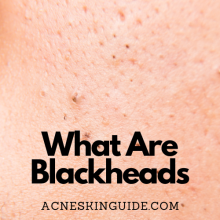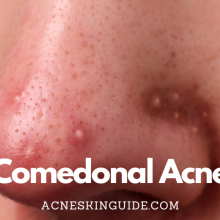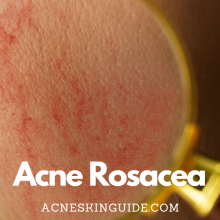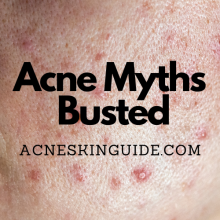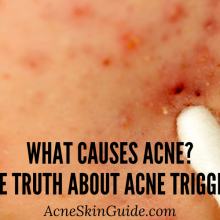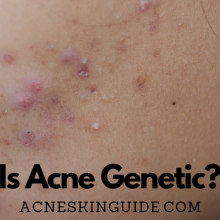Cystic Acne – Understanding, Treating, and Embracing The Journey | AcneSkinGuide
Cystic acne is a severe form of acne characterized by large, painful cysts that form deep within the skin, increasing the risk of scarring. Its development involves a complex interplay of hormonal imbalances, genetics, bacterial overgrowth, and lifestyle factors. Treating cystic acne requires a multifaceted approach combining topical treatments, oral medications, procedures, and complementary approaches like dietary changes and stress management.
Maintaining a consistent skincare routine, identifying triggers, and regular dermatologist follow-ups are crucial for prevention and management. While challenging, cystic acne can be managed with perseverance, professional guidance, and a tailored treatment plan that addresses both physical and emotional aspects of the condition.

Cystic Acne: A Comprehensive Guide to Understanding and Managing This Severe Condition
Cystic acne is a severe form of acne that can be both physically and emotionally taxing. Unlike regular acne, cystic acne manifests as large, painful, pus-filled cysts that form deep within the skin. These cysts are firmly embedded, making them difficult to treat and increasing the risk of scarring. Cystic acne commonly affects areas with a high concentration of oil glands, such as the face, back, shoulders, and chest.
Causes and Contributing Factors
The development of cystic acne is a complex interplay of various factors, including hormonal imbalances, genetics, bacterial overgrowth, and lifestyle choices. Hormonal changes during puberty, menstrual cycles, and pregnancy can trigger or exacerbate cystic breakouts. Additionally, individuals with a family history of severe acne are more prone to developing cystic acne due to genetic predisposition.
Bacterial overgrowth, particularly of the Propionibacterium acnes strain, can also contribute to the formation of these deep, inflamed cysts. Diet, stress, and lifestyle factors like smoking have also been linked to cystic acne flare-ups.
Treatment Options
Treating cystic acne often requires a multifaceted approach combining various therapies. Topical treatments, such as retinoids, benzoyl peroxide, and antibiotics, can help control symptoms and reduce inflammation. Oral medications, including antibiotics like doxycycline and hormonal therapies like spironolactone, target internal causes and can be effective for severe cases.
Procedures like extraction and cortisone injections, performed under the guidance of a dermatologist, can provide relief for individual cysts. However, it’s important to note that these procedures carry the risk of scarring and should only be performed by a qualified professional.
Combination regimens, which utilize multiple therapies simultaneously, are often the most effective approach for managing cystic acne. However, it’s crucial to be aware of potential side effects associated with each treatment and to discuss them with a dermatologist.
Complementary Approaches and Home Remedies
While not cures, certain home remedies and natural treatments can provide complementary benefits when used alongside medical treatments. For instance, tea tree oil, known for its antimicrobial properties, may help reduce inflammation and bacterial growth when applied topically. Dietary changes, such as reducing intake of dairy and high-glycemic foods, and incorporating supplements like zinc and omega-3 fatty acids, have also shown potential benefits for some individuals.
Managing stress through lifestyle modifications, such as exercise, meditation, and adequate sleep, can also aid in preventing cystic acne flare-ups.
Prevention and Management Strategies
Maintaining a consistent and gentle skincare routine is crucial for preventing and managing cystic acne. Avoiding harsh scrubbing or over-cleansing, which can further irritate the skin, is essential. Identifying and avoiding potential triggers, such as certain cosmetics or hair products, is also recommended.
Regular follow-up appointments with a dermatologist are key to monitoring progress and making adjustments to the treatment plan as needed. Additionally, being prepared for potential flare-ups and having a plan in place to manage them is essential.
Dealing with Cystic Acne Scars
Cystic acne often leaves behind stubborn, indented scars that can be challenging to treat. While preventative measures, such as avoiding picking or squeezing cysts, can help minimize scarring, some scarring may still occur.
Over-the-counter treatments containing ingredients like retinoids, vitamin C, and alpha-hydroxy acids can help improve the appearance of scars over time. However, for more severe scarring, professional treatments like lasers, microneedling, or dermal fillers may be necessary.
It’s important to remember that accepting and embracing scars through self-care practices is equally important for overall well-being.
Cystic Acne on Different Body Areas
While cystic acne is most commonly associated with the face, it can occur on any area of the body with a high concentration of oil glands, such as the back, chest, and shoulders. These areas may require specialized treatment approaches, as the skin in these regions can be thicker and more resistant to topical treatments.
Resources and Support
Dealing with cystic acne can be a challenging and isolating experience. Finding an experienced dermatologist who understands the intricacies of this condition is essential. Additionally, seeking support from online communities or in-person support groups can provide invaluable encouragement and advice from individuals facing similar struggles.
Utilizing educational resources and tracking treatment progress can also aid in maintaining consistency and identifying potential triggers or areas for improvement.
Additional Considerations
It’s important to be aware of common myths and misconceptions surrounding cystic acne, such as the belief that it is solely caused by poor hygiene or diet. Managing expectations and understanding that improvement can take months or even years is crucial to avoid disappointment and frustration.
Additionally, being prepared for potential flare-ups during certain seasons or weather changes can help mitigate the emotional toll of cystic acne. Recognizing and addressing the psychological impact, such as reduced self-esteem and confidence, through self-care practices and support networks is equally important.
Conclusion
Cystic acne is a severe and complex condition that requires a multifaceted approach combining medical treatments, lifestyle modifications, and emotional support. While the journey to clear skin can be challenging, perseverance and guidance from a qualified dermatologist can lead to significant improvements.
It’s important to remember that cystic acne is not a reflection of personal hygiene or lifestyle choices, and seeking professional help is crucial for effective management. With patience, commitment, and a tailored treatment plan, individuals can regain control over their skin and overall well-being.
Potential Downsides and Considerations:
- Side effects of medications: Certain oral and topical treatments for cystic acne can have side effects, such as dryness, irritation, photosensitivity, and gastrointestinal issues. It’s essential to discuss these with a dermatologist and weigh the potential benefits against the risks.
- Risk of scarring: Cystic acne has a higher risk of leaving behind permanent scarring, especially if the cysts are picked or squeezed improperly. This can have a lasting impact on an individual’s self-esteem and confidence.
- Long-term commitment: Treating cystic acne often requires a long-term commitment, as improvement can take several months or even years. This can be frustrating and emotionally draining, especially for those who do not see immediate results.
- Cost of treatments: Some treatments for cystic acne, such as professional laser therapies or dermal fillers, can be expensive and may not be covered by insurance plans, making them inaccessible for some individuals.
- Emotional toll: Cystic acne can take a significant emotional toll, leading to feelings of self-consciousness, anxiety, and depression. Seeking support and addressing the psychological impact is crucial for overall well-being.
- Recurrence: Even after achieving clear skin, cystic acne can recur due to hormonal changes, stress, or other triggers. Ongoing maintenance and management may be necessary to prevent future flare-ups.
It’s essential to have open discussions with a dermatologist and weigh the potential benefits and risks of different treatment options while also prioritizing emotional support and self-care throughout the journey.
FAQs and Answers
Can birth control pills help with cystic acne?
Yes, birth control pills can be an effective treatment option for cystic acne in women. Here’s how they can help:
- Hormonal regulation: Birth control pills contain synthetic forms of the hormones estrogen and progestin. These hormones help regulate the body’s natural hormone levels, which can be a key factor in controlling cystic acne.
- Reduced androgen levels: Cystic acne is often linked to increased levels of androgens (male hormones like testosterone) in the body. Birth control pills can help suppress androgen production, which can reduce the formation of cystic lesions.
- Decreased sebum production: Androgens also stimulate the production of sebum (oil) in the skin. By lowering androgen levels, birth control pills can help reduce excess sebum production, which can clog pores and lead to cystic breakouts.
- Anti-inflammatory effects: Some birth control pills have anti-inflammatory properties, which can help reduce the inflammation associated with cystic acne lesions.
It’s important to note that not all birth control pills are equally effective for treating cystic acne. Pills that contain both estrogen and progestin (combination pills) are generally more effective than progestin-only pills. Additionally, it may take several months for the full effects of birth control pills to be seen in improving cystic acne.
If you’re considering using birth control pills to manage cystic acne, it’s essential to consult with a dermatologist or gynecologist. They can help determine the most appropriate type and dosage of birth control pill for your individual needs and monitor your progress.
What is the role of diet in managing cystic acne?
Diet can play a significant role in managing cystic acne, although the relationship between diet and acne is complex and not fully understood. Here’s what research suggests regarding the role of diet in cystic acne:
- Dairy products: There is some evidence that consuming large amounts of dairy, particularly skim milk and whey protein, may exacerbate acne, including cystic acne. This could be due to the hormones naturally present in dairy or the ability of dairy to increase insulin levels.
- High glycemic index foods: Foods with a high glycemic index, such as refined carbohydrates, sugary foods, and processed snacks, can cause spikes in blood sugar and insulin levels. This can contribute to increased sebum production and inflammation, potentially worsening cystic acne.
- Omega-3 fatty acids: Incorporating more omega-3 fatty acids from sources like fatty fish, walnuts, and flaxseeds may help reduce inflammation associated with cystic acne.
- Antioxidants: A diet rich in antioxidants from fruits, vegetables, and green tea may help combat oxidative stress and inflammation, which could improve cystic acne symptoms.
- Low-glycemic diet: Some studies suggest that following a low-glycemic diet, which emphasizes foods that don’t cause rapid spikes in blood sugar, may help regulate insulin levels and improve acne.
It’s important to note that while dietary changes can be beneficial, they may not be a standalone cure for cystic acne. A combination of dietary modifications, topical and oral medications, and other treatments may be necessary for effective management.
Additionally, individual responses to dietary changes can vary, so it may take some experimentation to identify potential trigger foods. Consulting with a dermatologist or a registered dietitian can help develop a personalized dietary plan for managing cystic acne.
How can cystic acne be differentiated from other types of acne?
Differentiating cystic acne from other types of acne is important for proper diagnosis and treatment. Here are some key characteristics that can help distinguish cystic acne:
- Size and depth: Cystic acne lesions are typically larger, deeper, and more inflamed than other types of acne. They can be pea-sized or larger and extend deep into the skin.
- Appearance: Cystic acne lesions are often red, swollen, and painful. They may have a firm, fluid-filled center that feels like a hard knot or lump under the skin.
- Location: While regular acne can appear on the face, back, chest, and shoulders, cystic acne is more likely to occur on the lower face, jawline, and neck area.
- Scarring: Due to their deep nature, cystic acne lesions are more likely to cause scarring, especially if picked or popped.
- Duration: Cystic acne lesions can last for weeks or even months, whereas other types of acne may resolve more quickly.
In contrast, non-cystic acne lesions are typically smaller, more superficial, and less inflamed. These include:
- Whiteheads: Small, white bumps with a visible white center.
- Blackheads: Open pores clogged with oil and dead skin cells, appearing as small black dots.
- Papules: Small, solid, red bumps without a visible center.
- Pustules: Red bumps with a visible white or yellow center filled with pus.
It’s important to note that different types of acne lesions can coexist on the same person, and a dermatologist’s evaluation is crucial for an accurate diagnosis and appropriate treatment plan.
If you’re experiencing severe, deep, and painful acne lesions, it’s recommended to seek professional medical advice to determine if it’s cystic acne and to receive proper treatment to prevent scarring and manage the condition effectively.
Can cystic acne be a symptom of an underlying condition?
Yes, in some cases, severe cystic acne can be a symptom of an underlying medical condition. While cystic acne is often caused by a combination of factors such as hormonal imbalances, genetics, and bacterial overgrowth, it can also be linked to certain health conditions. Here are some examples:
- Polycystic Ovary Syndrome (PCOS): PCOS is a hormonal disorder that affects women of reproductive age. It’s characterized by high levels of male hormones (androgens), which can lead to excessive oil production and cystic acne breakouts, particularly along the jawline and chin area.
- Hormonal imbalances: Conditions that cause hormonal imbalances, such as congenital adrenal hyperplasia, Cushing’s syndrome, or hormone-secreting tumors, can contribute to the development of cystic acne.
- Endocrine disorders: Certain endocrine disorders, such as thyroid conditions (hyperthyroidism or hypothyroidism) or disorders affecting the pituitary or adrenal glands, can disrupt hormone levels and potentially trigger cystic acne.
- Metabolic disorders: Some metabolic disorders, like insulin resistance or high levels of insulin-like growth factor 1 (IGF-1), may increase the risk of developing cystic acne.
- Inflammatory conditions: Cystic acne can also be associated with inflammatory conditions like hidradenitis suppurativa, which causes painful, deep-seated lesions and scarring.
It’s important to note that while cystic acne can be a symptom of an underlying condition, it can also occur without any related medical issues. If an individual experiences severe, persistent, or treatment-resistant cystic acne, it may be worth investigating the possibility of an underlying condition, especially if there are other accompanying symptoms.
Consulting with a dermatologist and potentially seeking additional medical evaluations can help determine if cystic acne is a manifestation of a larger health issue. Proper diagnosis and treatment of any underlying condition, in addition to acne treatment, can be crucial for effectively managing cystic acne in these cases.
Is it safe to extract or pop cystic acne at home?
It is generally not recommended to extract or pop cystic acne lesions at home, as it can lead to further complications and scarring. Here are some important reasons why extracting or popping cystic acne at home is considered unsafe:
- Increased risk of scarring: Cystic acne lesions are deeply embedded in the skin, and attempting to extract them improperly can cause significant trauma to the surrounding tissue. This trauma can lead to the formation of permanent acne scars, including pitted or indented scars.
- Infection risk: Cystic acne lesions are already inflamed and infected. Popping or squeezing them can introduce more bacteria into the area, increasing the risk of further infection, inflammation, and potential complications like abscesses or cellulitis.
- Spread of bacteria: Attempting to extract cystic acne lesions with unclean tools or fingers can spread bacteria from one lesion to others, leading to the formation of new acne lesions or exacerbating existing ones.
- Increased inflammation: Squeezing or popping cystic acne lesions can cause significant trauma and inflammation, which can worsen the appearance and prolong the healing process.
- Inadequate drainage: Cystic acne lesions are deep and may not drain completely when popped at home, leaving behind residual inflammation and debris that can lead to further problems.
Instead of attempting to extract cystic acne lesions at home, it is recommended to seek professional treatment from a dermatologist or licensed esthetician. They have the proper training and tools to safely and effectively extract cystic acne lesions, if necessary, while minimizing the risk of scarring and infection.
In most cases, dermatologists will recommend medical treatments, such as oral or topical medications, to address cystic acne from the inside out rather than relying solely on extraction.
If a cystic lesion becomes extremely painful or shows signs of a severe infection (such as redness, warmth, and swelling), it’s important to seek prompt medical attention for proper treatment and to avoid potentially dangerous complications.

